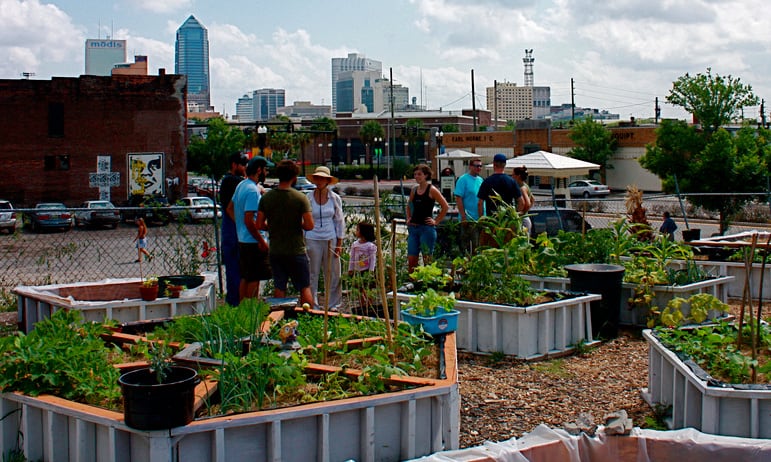City Blooming - An Overview
Wiki Article
How City Blooming can Save You Time, Stress, and Money.
Table of ContentsThe Ultimate Guide To City BloomingCity Blooming for DummiesThe Facts About City Blooming UncoveredWhat Does City Blooming Mean?The Definitive Guide to City Blooming
Intrigued in expanding food for sale in the City of Chicago? Below is a list of regularly asked concerns relating to the policies and policies that growers ought to think about when intending a city farming project.
The zoning modification does not modify any type of various other codes handling composting, building authorizations, purchasing or renting City owned residential property, business licenses or ecological contamination. There are existing codes that control these concerns and they remain completely impact and may be applicable to your job. Area gardens are usually had or managed by public entities, public organizations or community-based companies and preserved by volunteers.
Urban ranches expand food that is intended to be sold, either on a not-for-profit or for-profit basis. Due to their business objective, urban farms call for an organization license. Yes. A neighborhood yard is allowed to market surplus generate that was expanded on site if the sales are accessory or subservient to the garden's main function described over.
City Blooming Can Be Fun For Everyone
The amount of garden compost product can not exceed 25 cubic backyards at any type of provided time according to the criteria in 7-28-715 of the City's Municipal Code. Since the soil at the majority of new garden websites needs amending, compost, soil, wood chips, or other products can be gotten to create or improve the growing room.
If a structure authorization is required after that the hoophouse will be thought about an accessory building. You can learn even more concerning the structure permit requirements by speaking to the Division of Structures. The 25,000-square-foot dimension restriction is meant to stop a single community yard from controling an offered block or taking away from the block's existing property or industrial character.
The restriction does not relate to yards situated in Public Open Room (POS) districts. Can there be greater than one community garden that is 25,000 square feet on a solitary block? Yes. The size restriction relates to individual gardens, not to specific blocks. No. Fencing is not called for, however, gardens that have large parking lot might be needed to mount fencing or various other landscape design attributes.
Some Known Questions About City Blooming.
B1 & B2 areas need that all commercial use tasks be performed inside. Is fence required for urban farms? Fences might be required, along with landscaping and screening, for particular car parking locations and exterior job or storage space areas depending on place and the certain task taking location.Urban farms require building permits and zoning approvals prior to building (container and raised bed gardening etc.). Other kinds of city review may be called for depending on particular structures, tasks, size, landscaping, licensing, public health and stormwater administration concerns.
The Division of Service Affairs and Customer Defense can assist establish the certain kind of business license that's needed. Off road auto parking is required for many commercial tasks in Chicago. The called for number of car park areas is based on the number of workers working on site and not the square video footage of the expanding area.
The 4-Minute Rule for City Blooming

Yes. A metropolitan ranch can websites offer garden compost product created on site, however, the operation has to follow the policies in 7-28-715 of the Chicago Municipal Code. Yes. Aquaponic systems are enabled inside your home on urban farms in many zoning districts. However, a zoning evaluation and structure license is called for in order to install structures or systems and a business certificate is needed as defined above.
Up to 5 hives or colonies of honey may be kept as an accessory use. Nevertheless, beekeepers need to register with the Illinois Department of Farming. To learn more concerning the proposed zoning change you might call the Department of Housing and Economic Growth, Bureau of Planning and Zoning at 312.744.8563.
Farming in cities and metropolitan areas An urban ranch in Chicago. Urban agriculture refers to different methods of growing. https://x3n7gir0m43.typeform.com/to/xy4y6eO6, handling, and distributing food in city areas. The term additionally applies to the area tasks of animal husbandry, aquaculture, beekeeping, and cultivation in an urban context. Urban agriculture is identified from peri-urban agriculture, which happens in backwoods at the side of suburban areas.
The 6-Minute Rule for City Blooming
It can include a motion of organic farmers, "foodies" and "locavores", that look for to form socials media based on a shared ethos of nature and community holism. These networks can create by way of formal institutional assistance, coming to be integrated into local town planning as a "transition town" motion for lasting city advancement.The a lot more straight access to fresh vegetable, fruit, and meat products that might be realised through urban farming can enhance food security and food security while lowering food miles, leading to reduced greenhouse gas exhausts, consequently contributing to environment change reduction. Several of the very first evidence of urban farming originates from Mesopotamia.
Report this wiki page